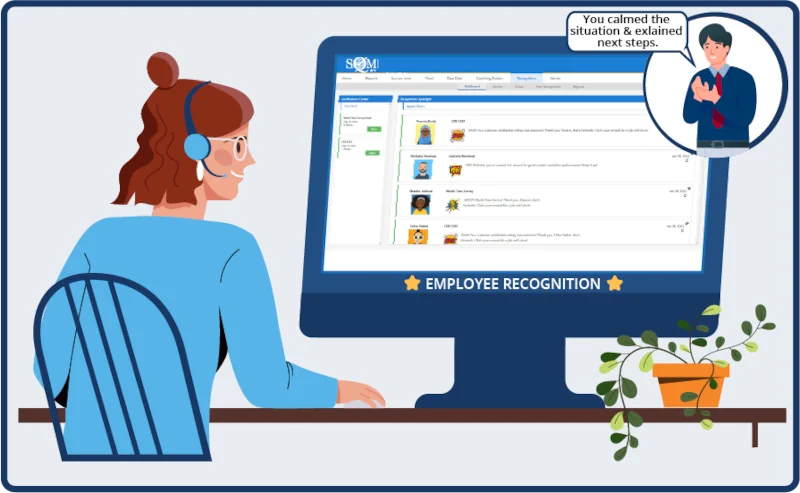The role of a contact center agent is changing faster than ever. Customers expect quick answers, clear communication, and support that feels personal—not scripted. To meet these expectations, today’s agents need a toolkit that goes far beyond memorizing procedures. They must communicate well, handle multiple technologies with ease, adapt to new situations, and solve increasingly complex problems.
These growing expectations mean that the skills that once guaranteed success now only cover part of the job. A strong voice and a positive attitude still matter, but modern customer interactions also require agents to stay calm under pressure, understand digital tools, and think through problems independently. The more prepared agents feel, the more confident and effective they become.
At SQM Group, we see this shift every day through customer feedback, FCR results, and QA performance. Agents who keep building new skills deliver better experiences, grow faster in their roles, and stay ahead of industry changes. In simple terms: agents who keep learning stay ahead—those who don’t, fall behind.
This blog outlines seven essential pieces of the modern agent toolkit for 2025 and beyond. Each section includes a real-world example to help leaders coach these abilities and help agents apply them on the job.
1. Communication Skills That Build Trust
Clear communication is one of the most important parts of the agent’s experience. Customers want to feel heard, supported, and confident that the agent understands their problem. When agents communicate well, confusing situations become clearer, emotions calm, and solutions feel easier to reach.
Strong communication also prevents misunderstandings that can lead to repeat calls—a major frustration for both customers and contact centers. When agents take a moment to clarify, confirm, or explain, it builds trust and sets up the interaction for a smoother resolution.
How strong communication shows up during real calls
Communication skills appear through simple behaviors: asking clarifying questions, summarizing the issue with clarity, keeping a steady tone, and checking for understanding without sounding unsure. These steps make customers feel respected and reassured.
Example:
A customer says, “I keep getting locked out of my account.”
A strong communicator replies:
“Let me make sure I understand—you're entering the correct password, but the system isn’t accepting it. I can help you reset it and check what caused the lockout.”
This creates trust by confirming understanding and setting a clear path forward.

2. Digital Confidence and Navigation
Today’s agents work inside multiple tools at once—CRM systems, chat platforms, knowledge bases, call controls, and sometimes AI assistants. “Digital confidence” doesn’t require deep technical skills. It means staying comfortable and organized while switching between screens or channels.
Agents who navigate tools smoothly help customers faster, keep conversations flowing, and avoid long silences or errors that break trust. This kind of digital comfort also makes it easier for agents to adopt new systems as they are introduced.
How digital confidence helps the customer experience
Digital confidence includes knowing where to find information, switching channels while keeping context, and using tools without interrupting the conversation. Contact centers often see higher FCR and CSAT where agents feel at ease using their systems, rather than fighting against them.
Example:
A customer begins in chat but asks, “Can we switch to a call?”
A digitally confident agent moves to voice, opens the chat transcript automatically, and continues without asking the customer to repeat anything.

3. Problem-Solving Abilities
Customers rarely contact support because a simple fix failed—they call when the issue is confusing, unexpected, or too complex to solve alone. Agents need problem-solving skills to uncover the root cause and provide a complete solution.
Good problem solvers think step-by-step, ask meaningful follow-up questions, recognize patterns, and connect the dots. These abilities improve First Call Resolution (FCR), reduce repeat contacts, and create more confidence in the service provided.
How agents identify and resolve the root cause
Problem-solving shows up when agents troubleshoot beyond the surface, review related systems, or verify details to make sure they’re addressing the full issue—not just the immediate complaint.
Example:
A customer reports duplicate charges.
A skilled problem-solver checks:
✔ Auto-renew settings
✔ Whether the card is saved twice
✔ Whether the customer accidentally created two accounts
Finding the real cause prevents future issues and builds trust in the solution.

4. Adaptability in a Fast-Changing Environment
Policies, tools, and customer expectations shift constantly in contact centers. Agents who adapt quickly respond better when something unexpected happens. Adaptability helps them stay calm, adjust smoothly, and keep the interaction moving even when the situation changes.
Agents with strong adaptability reduce stress for both them and the customer. They handle updates confidently instead of resisting change or becoming overwhelmed, which helps maintain stable performance even during periods of change.
How adaptable agents handle new or unexpected situations
Adaptability shows up through steady reactions, willingness to learn, and confidence with new processes—even when they are introduced with little notice. Contact centers often see higher engagement and lower burnout in teams where change is supported and adaptability is encouraged.
Example:
A customer calls about a product feature updated last week.
An adaptable agent says:
“That feature changed recently—let me walk you through how it works now.”
They handle the change with ease instead of getting stuck.

5. Emotional Control & Professional Composure
Agents handle customers on their best and worst days. Some callers arrive calm, and others arrive frustrated before the agent says a word. Emotional control helps agents stay steady, patient, and focused no matter the tone of the customer.
This skill allows agents to prevent situations from escalating. When the agent stays calm, the customer often follows. Emotional control also helps agents protect their own well-being, especially during high-volume or high-stress periods.
How emotional control keeps conversations on track
Emotional control appears when agents avoid taking comments personally, maintain an even tone, pause before reacting, and guide the conversation back toward solutions. Customers will respond more positively when they feel an agent stays respectful and composed—even in a difficult situation.
Example:
A customer says, “I’ve called three times and no one has helped me!”
A composed agent responds:
“I’m really sorry you’ve had to reach out again. Let me take ownership and work on getting this fixed for you now.”
They acknowledge the frustration without mirroring the intensity.

6. Growth Mindset: Always Learning, Always Improving
The contact center environment moves quickly—new tools, new products, new customer expectations. Agents with a growth mindset stay open to learning and see feedback as a chance to improve, not just as criticism. This mindset helps them stay confident and prepared for the changes ahead.
Agents with a growth mindset improve faster, embrace coaching, and adjust to new processes more easily. They see development as part of the job rather than something extra.
How a growth mindset appears in everyday work
A growth mindset shows up when agents ask for feedback, practice new methods, learn from mistakes, and stay curious about updates. Tools like mySQM™ Auto QA and Agent Self-Coaching can support this by giving agents easy access to their own results, customer comments, and call insights—so they can see what’s working and what to work on next.
Example:
After a difficult call, an agent looks at their customer feedback and QA results, then asks their coach,
“What can I do differently next time?”
That question leads to learning, confidence, and stronger performance over time.

7. Recognition That Keeps Agents Engaged
Skills grow faster in environments where agents feel appreciated. Recognition turns effort into motivation. When agents receive credit for improvements in FCR, CSAT, soft skills, or handling tough calls, they are more likely to repeat those behaviors and keep developing.
Recognition doesn’t always mean big rewards—often, quick acknowledgment of a job well done makes the biggest difference. It also helps connect daily work to larger goals, showing agents that their contributions matter.
How recognition supports long-term skill growth
Effective recognition is specific and timely. It focuses on what the agent did well (“You calmed the situation and clearly explained next steps”) rather than vague praise (“Good job”). Over time, this kind of feedback shapes habits.
The mySQM™ Rewards & Recognition program makes it easy to tie recognition directly to customer feedback and QA results. Agents can earn points for positive surveys, strong QA performance, and FCR achievements, which helps them see a direct link between their skills and the recognition they receive.
Example:
A customer leaves a high CSAT score with a comment praising how clearly the agent explained the solution. The agent receives real-time recognition through mySQM™, along with points toward a reward. That moment reinforces the exact behavior the organization wants to see more of.

The Toolkit That Helps Agents Thrive
Today’s agents need more than basic service skills—they need strong communication, digital confidence, problem-solving ability, adaptability, emotional steadiness, a growth mindset, and recognition that reinforces their efforts. When these elements work together, agents feel more prepared, customers feel more supported, and the entire contact center performs at a higher level.
With consistent coaching, tools like mySQM™ Auto QA and Rewards & Recognition, and a culture that encourages development, organizations can help agents keep building their toolkit over time. In 2025 and beyond, building these skills isn’t optional, it’s the advantage that helps agents thrive instead of falling behind.
